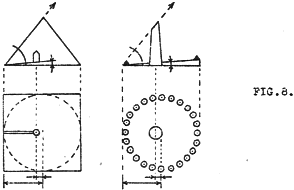
Mike Saunders’ 1976 booklet Databank for an Inhabited Extrasolar Planet was added to the original folio, but is now lost except for a photocopy of the page below. A shorter version of the booklet was published as a paper in Journal of the British Interplanetary Society, 30, 349–358 (September 1977).
{15}
The logic of the system must be sound. That is: the most fundamental aspects of the monuments, should indicate the most fundamental aspects of the planetary bodies. For instance: it could be arranged that the most basic structural parameters, indicate the most basic orbital elements and planet dimensions.
The examples given in this paper, attempt this. They employ a primary structure whose base dimension; chamber position; and corridor angle; indicate corresponding orbital elements. And they employ a secondary structure whose baselength; aspect ratio; and axial inclination; indicate corresponding planet dimensions.
It might be found, even with a system designed in a consistent and precise way, that less-fundamental structural dimensions, such as base-diagonals; sloping-diagonals; etc, could, by chance, be related to other planetary bodies. Consequently, before finally deciding upon a system, it would be necessary to check that spurious relationships did not accidentally provide a “group of associations” with some other body in the planetary system. (Isolated spurious relationships would probably be unavoidable, but these would hardly mislead careful observers when the time came.)
It would also be worth estimating, the chance of spurious relationships resulting from any structures that might be built at later times, by the inhabitants unaided. This estimate (combined with knowledge, such as that supplied by Dr Mendelssohn, of why, and at what stage, civilisations build massive solid structures) might be sufficient to assist the final decisions about the nature, and size, of the indicating monuments.
Instead of a solid triangular structure, a central obelisk with surrounding stones could be employed. See Fig. 8. The basis of this approach was suggested by Robert Forrest.
The number of stones could be made to represent some parameter of the chosen planet; such as the number of days in its year.

The obelisk structure might be much less durable. For example: damage to the obelisk could greatly alter the slope. Whereas, with the simple triangular structure, the slope would be preserved over a large area, and could be estimated quite well; even after damage to many parts of the sloping surface. An obelisk structure could not be made with the massive proportions that would be possible with a triangular structure. However, in certain situations, these apparent disadvantages might constitute safeguards.
Maybe there are several further structures which might be used to indicate a site in a planetary system.